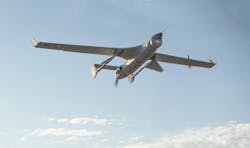Navy asks Boeing Insitu to provide new small unmanned aircraft with sensor payloads for reconnaissance
PATUXENT RIVER NAS, Md. – U.S. Navy unmanned aerial vehicle (UAV) experts needed small reconnaissance UAVs for the Navy and U.S. allies. They found their solution from Boeing Insitu in Bingen, Wash.
Officials of the Naval Air Systems Command at Patuxent River Naval Air Station, Md., announced a $12.5 million order to Boeing Insitu last Thursday to provide RQ-21A Blackjack UAVs and ScanEagle UAVs, spart parts, and support for the Navy and U.S. foreign military sales (FMS) customers.
The Boeing Insitu RQ-21 is a twin-boom, single-engine, monoplane UAV for surveillance and reconnaissance. It an be launched and recovered on land or at sea without runways, using a pneumatic launcher and net-type recovery system.
The 81-pound Blackjack is eight feet long with a 16-foot wingspan designed to carry multi-sensor payloads in large pod below its nose. The UAV can fly as quickly as 104 miles per hour, cruises at 63 miles per hour, can fly as long as 24 hours, and can fly as high as 19,500 feet. It is a version of the Insitu Integrator UAV.
The multi-mission RQ-21A Blackjack's open-architecture payload bays can be customized with visible-light and infrared cameras, communications and other tools to give warfighters on the forward edge of battle situational awareness information.
It can integrate new payloads quickly, offers roll-on, roll-off capability to move the system quickly from ship to shore, and aboard cargo aircraft. The UAV can carry sensor payloads as heavy as 39 pounds.
The Blackjack's standard sensor payload consists of a visible-light imager, mid-wave infrared imager, laser rangefinder, infrared marker, communications, and automatic identification system.
The RQ-21A is for persistent maritime and land-based tactical reconnaissance, surveillance, and target acquisition (RSTA) data collection and dissemination capabilities to the warfighter.
The Boeing Insitu ScanEagle UAV, meanwhile, is 5.1 feet long with a 5.6-foot wingspan. It weighs as much as 48.5 pounds and can carry a 7.5-pound sensor payload. The UAV can fly for more than 24 hours at altitudes as high as 19.500 feet, and at speeds to 80 knots.
The ScanEagle UAV can fly on gasoline or heavy fuels like jet fuel, diesel, or kerosine. It provides persistent surveillance and reconnaissance imagery on land or at sea at lower costs than other surveillance methods for military and agriculture missions.
ScanEagle can carry a sensor payload consisting of visible-light camera, medium-wave infrared imager, or both integrated in one turret. The UAV ans has an analog digitally encrypted video data links, as well as encrypted or unencrypted command-and-control data links.
The UAV can be launched autonomously and uses a no-nets recovery system that recovers with its wing tip on a rope that hangs from a boom.
On this order Boeing Insitu will do the work in Bingen, Wash., as well as at locations outside and inside the continental U.S., and should be finished by June 2022. For more information contact Boeing Insitu online at www.insitu.com, or Naval Air Systems Command at www.navair.navy.mil.

John Keller | Editor-in-Chief
John Keller is the Editor-in-Chief, Military & Aerospace Electronics Magazine--provides extensive coverage and analysis of enabling electronics and optoelectronic technologies in military, space and commercial aviation applications. John has been a member of the Military & Aerospace Electronics staff since 1989 and chief editor since 1995.

